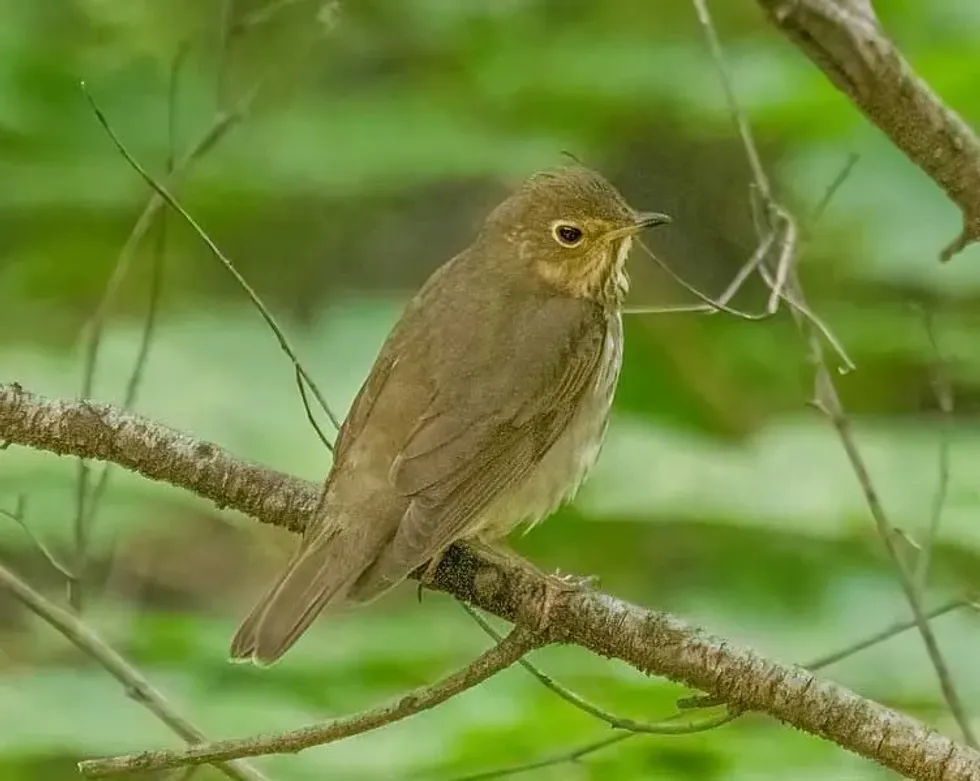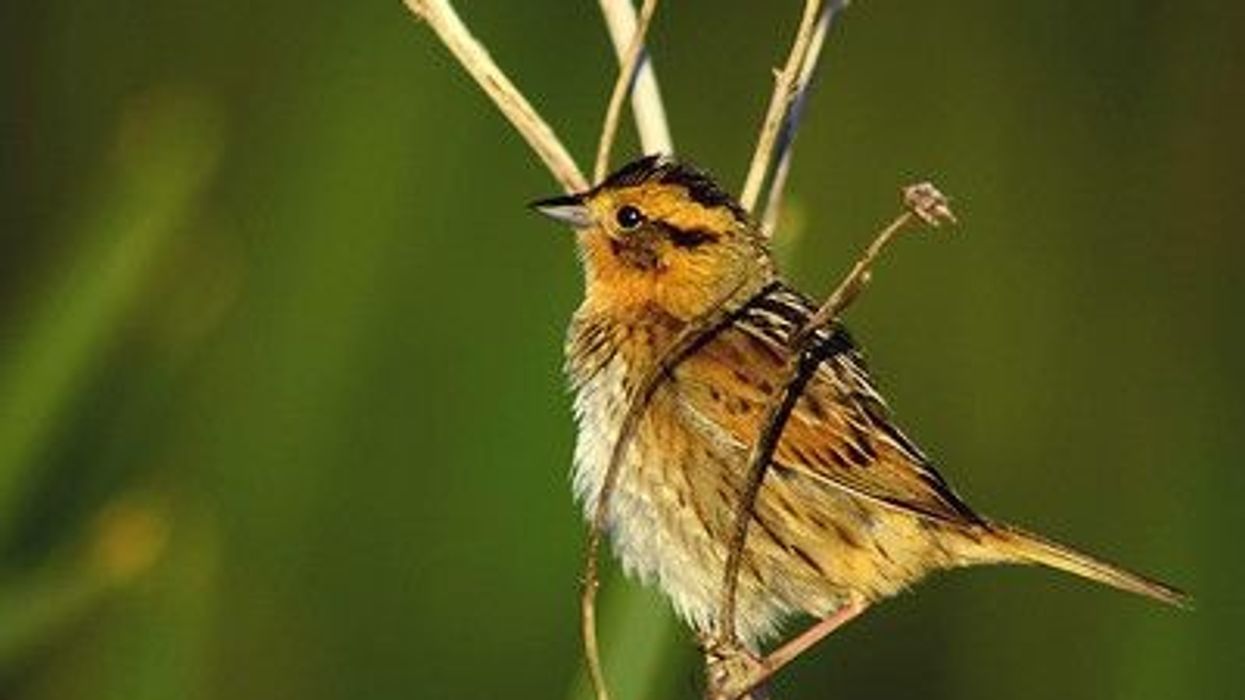Swainson's thrush (Catharus ustulatus) is a member of the Turdidae family. The range of this bird includes Alaska and Canada, where breeding happens.
It is also found in mountains in the west and around the Pacific coast of North America and is known to winter in parts of South America and Mexico. It is known as russet-backed thrush and olive-backed thrush in the western boreal region of the Pacific coastal region and the Appalachians, the Rockies, and the eastern boreal region respectively.
Swainson's thrush habitat woodlands or woodland thickets streamside and breeding habitat includes coniferous and deciduous forest range and is found in tropical forests in the winter season. A male breeding bird is known to arrive at the breeding grounds early during the breeding season and establish its territory.
It breeds in dense undergrowth. A male is known to sing in order to attract females.
The nest is built by the female using grasses, mud, and twigs, and this nest is placed on horizontal branches of conifer and deciduous trees. Three to four eggs are laid and incubation is done by females for about 12 days and the chicks leave after 12 days of hatching.
Four subspecies have been recognized. These birds are medium-sized and are olive-brown in color with whiter underparts.
The legs and feet are pink colored and the bill is yellow and known to have a black tip. Adult male and female look similar and the young ones also look similar to an adult. These birds are under the Least Concern category of conservation status.
Swainson's thrush song and calls are known to be distinctive. These birds feed on insects, berries, and fruits.
It is quite interesting to learn about this species of thrushes and if you are interested, read about these eyebrowed thrush facts and wood thrush facts too.
Swainson's Thrush Interesting Facts
What type of animal is Swainson's thrush?
Swainson's thrushes are birds.
What class of animal does Swainson's thrush belong to?
It belongs to the class of Aves of birds.
How many Swainson's thrushes are there in the world?
There has been no specific number or count of the Swainson's thrush population in the world.
Where does Swainson's thrush live?
The breeding of this species takes place in Alaska and Canada. It is also found in mountains in the west and around the Pacific coast of North America. This species is known to winter in South America and Mexico.
What is Swainson's thrush's habitat?
The breeding habitat of this species inhabit includes coniferous and deciduous forests. They also inhabit woodlands or woodland thickets streamside. They are known to migrate in the winter season and winter is spent in tropical forests.
Who do Swainson's thrushes live with?
Not much information is available about the behavior of these birds or thrushes but they are known to live alone and can sometimes live in groups too.
How long does Swainson's thrush live?
The exact lifespan of this species is unknown but the longest living record of this species is known to be around 12 years and one month old.
How do they reproduce?
For breeding or mating to take place, a male breeding bird of this species arrives at the breeding grounds early during the breeding season and establishes a territory, and then starts to attract females by singing. These thrushes can form pairs for the long term but are known to not mate for life.
It breeds in dense undergrowth in woodlands of coniferous.
The nest of this bird is placed or built in a low conifer or deciduous tree around 2-10 ft (0.6-3 m)above the ground. It is shaped like a cup and made or built with stems, grasses, mud, twigs, and moss and placed on a branch that is horizontal in shape.
This nest is known to be built by females. Around three to four eggs are laid by the female and these eggs are blue or greenish-blue in color which is spotted with a reddish-brown color.
Incubation takes place for about 12 days and is done by females.
Newborns are helpless and both parents are known to feed the young ones. The young ones or chicks leave the nest after 12 days of hatching.
What is their conservation status?
The conservation status of these Swainson's thrushes population is Least Concern as listed by the International Union for Conservation of Nature (IUCN).
Swainson's Thrush Fun Facts
What do Swainson's thrushes look like?
Swainson's thrushes are known to be medium-sized thrushes with olive-brown colored bodies on the upperparts and are white on the underparts or below. Swainson's thrush winter plumage and the summer one are similar but the differences in plumage can be spotted in population in different regions.
These birds of North America are also known to have a distinctive light brown colored eye-ring. Spotting appears on limited parts like the lower breasts and flanks, unlike a song thrush which has a fuller spotting on the underpart.
The eyes of these thrushes are dusky and the legs and feet are known to be flesh-like or pink colored.
The bill is known to have a black tip and is yellow-colored. Both adult males and females look similar and the young ones are also known to have a similar appearance to the adults.
How cute are they?
These birds are considered cute only because of their size.
How do they communicate?
Not much information is available regarding the communication of these Swainson's thrushes but just like other birds, they also produce sounds and calls to communicate with each other.
How big is Swainson's thrush?
These birds are known to be medium-sized and are sized between a sparrow and a robin. The length of these birds ranges from 6.3-8 in (16-20 cm).
How fast can Swainson's thrush fly?
Thrushes are known to travel at a speed of about 29 mph (47 kph) and are known to spend more time flying and on branches of trees than on the forest floor.
How much does Swainson's thrush weigh?
The weight of these birds range from 0.81-1.59 oz (23-45 g).
What are the male and female names of the species?
There are no specific names for the males and females of the species.
What would you call a baby Swainson's thrush?
While there is no particular name for a baby of this species, it is generally referred to as chicks or juveniles.
What do they eat?
Swainson's thrush diet or food includes insects, berries, and other fruits. They are also known to eat some invertebrates and spiders.
Are they friendly?
Not much is known about the Swainson's thrush bird being friendly or not.
Would they make a good pet?
Not much information is available about these thrushes as pets and it is believed that they would not make great pets as they are wild and migratory.
Did you know...
Swainson's thrush (Catharus ustulatus) is also known as russet-backed thrush and olive-backed thrush in the western boreal region of the Pacific coastal region and the Appalachians, the Rockies, and the eastern boreal region respectively.
Four subspecies of this bird have been recognized, namely Catharus ustulatus alame, Catharus ustulatus swainsoni, Catharus ustulatus ustulatus, Catharus ustulatus oedicus. The subspecies C.u.
alame and C.u. swainsoni are found in the eastern part of the range that includes the Cascades, British Columbian Coast Mountains, and the Sierra Nevada while the other two subspecies are found in the western part of this range.
The population of this bird found in the east is more olive-brown in color while the population found in the west is reddish-brown in color.
This bird is known to be the only woodland thrush whose song has been recorded to go up in a pitch and its voice is referred to as ascending flute voice.
These birds are known to spend less time on the ground and can be occasionally or rarely seen standing or running on the forest floor.
The Swainson's thrush range is known to overlap with a hermit thrush.
What does Swainson's thrush sound like?
Swainson's thrush call or song sounds like a low whit and can also be described as a 'whup' that is soft. The song is known to be ascending flute voice or spiral of whistles and the song is known to be very distinctive.
Swainson's thrush vs hermit thrush
Swainson's thrush or the olive-backed or russet-backed thrush is known to have a more prominent eye-ring than the hermit thrush. The tail of the former is known to not contrast with its back while the tail of the latter is reddish in color which contrasts with its brown back.
Here at Kidadl, we have carefully created lots of interesting family-friendly animal facts for everyone to discover! For more relatable content, check out these varied thrush facts and northern waterthrush facts pages.
You can even occupy yourself at home by coloring in one of our free printable swainson's thrush coloring pages.










